¶ Introduction
An aerodrome traffic pattern is used by VFR traffic for training purposes or to prepare the aircraft for landing operation. Normally this pattern has a rectangular shape.
Some traffic pattern specific details may be published on a Visual Approach Chart (VAC) of the aerodrome.
¶ General presentation
¶ Standard circuit parameters
The standard circuit pattern is left hand pattern where all 90° turn are taken to the left. When you don't have any information about circuit pattern orientation, it will be preferable to choose left handed pattern if you can't get any information from ATS service.
The standard circuit parameters are:
- All turn angles are 90°.
- All turns shall be taken to the left: that's left hand circuit.
- The circuit shall be performed at 1000ft above the ground (AGL)
or airfield elevation.
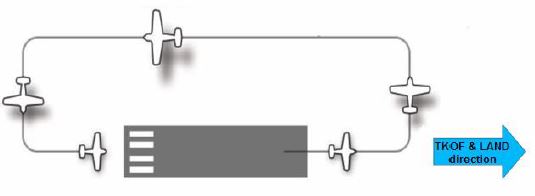
Figure: standard (left) traffic pattern
You must use the general parameters when:
- You have no charts of the airfield.
- Some parameters are not published on charts.
¶ Parameters published on charts
Be careful, sometimes on charts, all or part of the parameters can be published:
- Circuit pattern form (angles of turn on some legs) cannot always be rectangular.
- Turn orientation can be left, right or both.
- Specific Altitude or height (AMSL or AGL) can be different than 1000ft AGL.
- Specific touchdown points.
Some situations, such as terrain, noise-sensitive areas, cities, natural parks, require all turns in the aerodrome traffic circuit to be made to the right. This is then called a right hand pattern.

Figure: right traffic pattern
It is not unusual to find a runway served by a standard (left) pattern when used in the one direction and by a right hand pattern in the opposite direction, thus the pattern will always be on the same side of the runway.
Since left-hand circuit is standard, the words "left hand" will normally not be used. To differentiate with the non-standard right-hand circuit, always the words "right-hand" will be used when proceeding in a right-hand visual circuit.
- 📡D-ECHO, enter downwind runway 34 -> This will be the left downwind of the runway.
- 📡D-ECHO, enter right downwind runway 34 -> This will be the right downwind of the runway.
¶ Circuit pattern legs
A circuit pattern is divided into different legs:
- Upwind leg
- Crosswind leg
- Downwind leg
- Base leg
- Final
This chapter will study the circuit pattern legs with a light aircraft (step by step).
¶ Upwind leg
The upwind leg begins at the point where the airplane leaves the ground.
The purpose of this leg for the aircraft is climbing at safe altitude greater than 500ft AGL, then at the pattern altitude.
We will continue climbing straight ahead to gain sufficient altitude before the 90-degree turn to the crosswind leg. Notice that the upwind leg is identical for a standard and non-standard pattern.
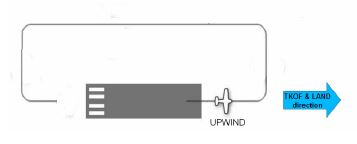
¶ Crosswind leg
The first 90° turn will place the plane under a perpendicular route from the runway axis: it's the crosswind leg. Except in special cases, this turn shall not be performed before 500ft AGL.
You are now entering the traffic side of the circuit: watch for aircraft joining the circuit on crosswind or on beginning of downwind.
The crosswind leg is a flight path at a 90° angle to the take-off direction. After making a left turn from the upwind leg one enters the crosswind leg. This turn is made at a safe height, while the climb is continued towards the indicated or cleared circuit altitude.
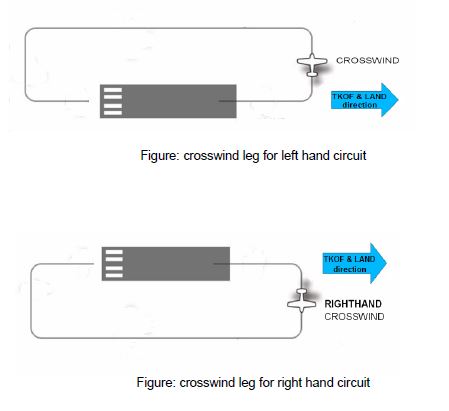
¶ Downwind leg
The second 90° turn will place the plane under a parallel route from the runway axis: it's the downwind leg.
The downwind leg is a flight path at a 180° angle (opposite) to the take-off direction.
Except when the circuit altitude is published, this leg is performed at 1000ft AGL at about 1NM to 2NM distance from the runway.
The pilot must check the crosswind drift against selected landmarks and adjust heading to track parallel to the runway, perform the appropriate downwind cockpit checks and hold altitude and appropriate traffic spacing.
The downwind leg will be flown at moderate speed, adjusted to avoid overtaking preceding aircraft, and holding a constant height. He must set adequate power and trim the aircraft to maintain an airspeed which allows time to plan the landing without unnecessarily delaying other traffic -- probably around 1.7 x Vso.
The pilot shall maintain visual separation with outside landmarks and keep the runway in sight. In the last third of the downwind, approach configuration is set.
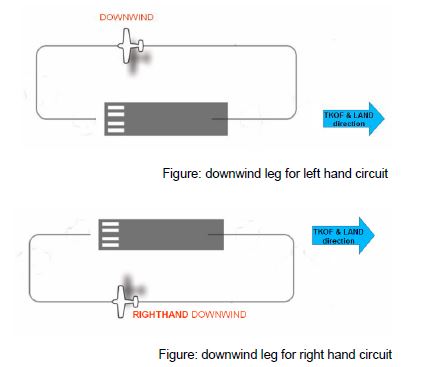
When reaching the point when you are overtaking the runway's threshold, the pilot shall extend the downwind about 1.6NM (it shall be reduced to 1NM for training). The threshold shall be at approximately 45 degrees from the aircraft position before turning to final.
¶ Base leg
The third 90° turn will place the plane under a perpendicular route from the runway axis: it's the base leg. The pilot shall perform this turn when the runway threshold is in sight with about 45° rear angle.
The base leg is a flight path at a 90° angle to the landing runway direction and connects the downwind leg to the final approach leg. During base leg, the pilot initiates the descent to reach about 500ft AGL at the end of the leg.
The pilot holds airspeed but reduces power so that a descent is started.
He lowers the first stage flap if so equipped, then he reduces airspeed [but not less than 1.5 x Vso] and trim.
The time spent flying the base leg is most important, providing the opportunity to set up the aircraft in the approach attitude:
- to establish a power and flap setting [and trim] for the required rate of descent
- to check for conflicting traffic both airborne and on the ground and particularly any traffic on a straight-in approach or very wide circuit;
- to assess the crosswind component along the landing path
- to decide the touchdown technique appropriate for the conditions and to review the pre-landing checks.

¶ Final
The last 90° turn will place the plane on the runway axis in order to land on the runway: it's the final. This turn shall normally be performed to reach 500ft AGL when finished. During final, the pilot prepares his plane for landing: flaps configuration, speed near 1.3 x Vso (stall speed).
The final approach leg is a flight path in the direction of landing from the base leg to the runway.
Don't forget to extend the gear if needed!
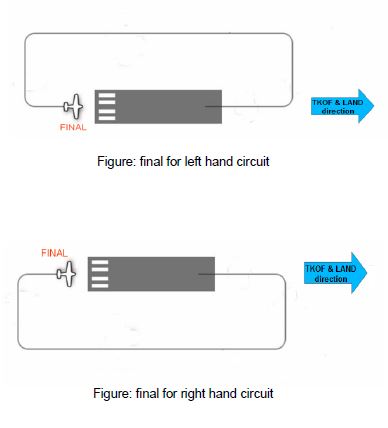
¶ Summary of the traffic pattern
- Take off point on the runway
- End of climb out on upwind leg
- Crosswind leg
- Downwind leg
- Turning on base leg (end of downwind)
- Base leg
- Turning on final (end of base leg)
- Short final
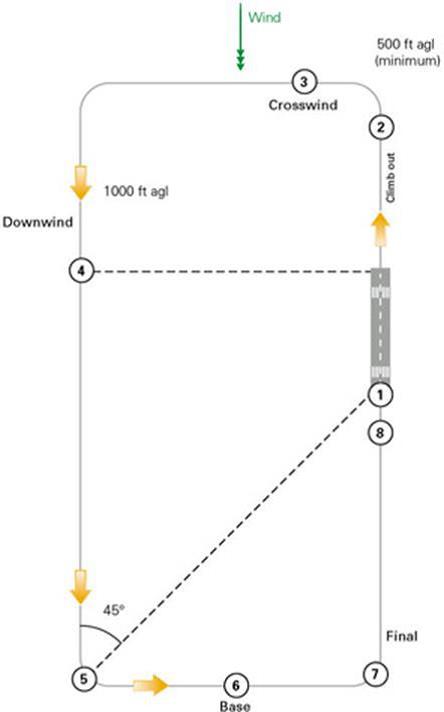
- none
- VID 150259 - Creation
- VID 435695 - Wiki integration
- VID 496402 - Wiki.js integration